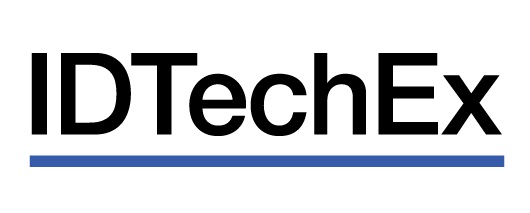
Thermal Interface Materials: Diverse, Essential, and Evolving
CAMBRIDGE, UK / AGILITYPR.NEWS / July 02, 2020 / Thermal Interface Materials (TIMs) are a diverse and growing market. IDTechEx Research has analysed the market in depth in their report, “Thermal Interface Materials 2020-2030: Forecasts, Technologies, Opportunities”. The highly granular and finely segmented market forecast from IDTechEx are shown below. The market is growing, and its composition is changing. Naturally, suppliers will have to adjust and reposition their TIM product portfolio to capture these rising markets in electric vehicles, 5G, datacentres, autonomous driving, etc.
Inherently, the TIM market is also fragmented on the technology or solution level. In fact, there is no one-sizes-fits-all product. The radar chart below shows a high-level comparison of some of the common solutions, highlighting the diversity of solutions. The TIM material’s menu resembles a toolkit for thermal engineers who can select the material with the right form factor, thermal conductivity, operating temperature, thickness, etc for their specific needs. For a detailed analysis of the existing and emerging TIM materials, please see the IDTechEx report, “Thermal Interface Materials 2020-2030: Forecasts, Technologies, Opportunities”.
This article highlights some key material development trends. More specifically, approaches to increase the thermal conductivity (in W/mK) of TIMs are considered. This is an important trend because the IDTechEx assessment is that the market, in absolute terms, for high or ultrahigh thermal conductivity TIM materials, will inevitably rise. As such, suppliers will need to develop new solutions to extend their TIM portfolio into the high or ultrahigh thermal conductivity segment or risk being stuck in commoditized low-cost low-margin mature market segments and risk losing out on many emerging trends.
This article is extracted from the comprehensive IDTechEx report on the topic, “Thermal Interface Materials 2020-2030: Forecasts, Technologies, Opportunities”. This report provides a highly granular view of the market, breaking IDTechEx forecasts down by 51 sub-segments. The major categories covered include consumer electronics, 4G and 5G, electric vehicle batteries, LEDs, data centres, power electronics, and so on. Furthermore, the report assesses the existing and emerging TIM technologies including alumina, boron nitride, graphite, vertically aligned graphite, PGS, graphene, carbon nanotube forests, boron nitride nanotubes, and more. This report is a must-read for those interested in the TIM market.
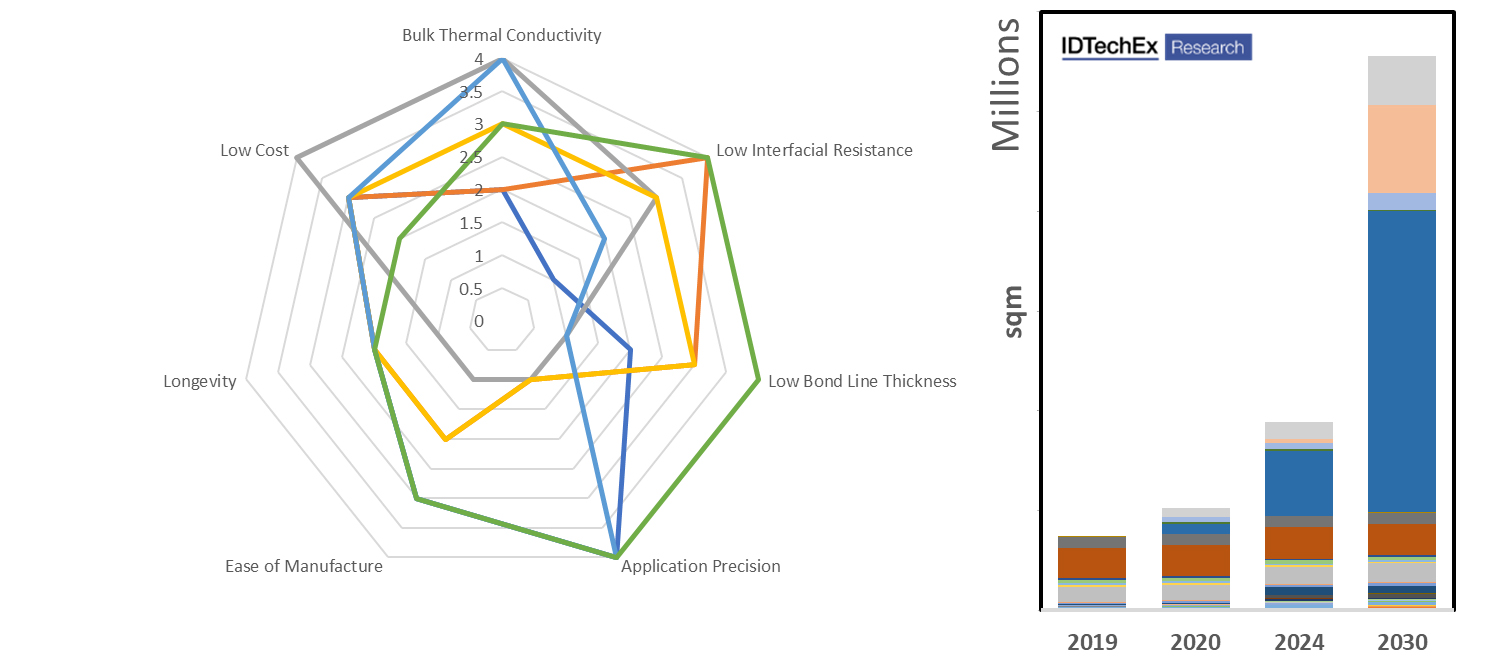
Left: Radar chart comparing, at a high level, various TIM solutions including thermal grease, pads, adhesive tapes, and phase change materials. Right: Market forecasts in sqm segmented by 51 sub-segments, showing that the market is set for growth and transformation. For more information, please visit “Thermal Interface Materials 2020-2030: Forecasts, Technologies, Opportunities”.
Increasing Thermal Conductivity
Thermal conductivity is a key performance indicator. In general, higher thermal conductivity solutions command a higher per sqm or per Kg price. They are therefore used only where needed.
What is a typical thermal conductivity? The chart below shows the thermal conductivity of various types of thermal interface solutions. They are taken from the standard catalogue of the top TIM suppliers worldwide. As such, they represent typical products on the market today. In general most solutions are <5 W/mK. Some mass production solutions reach 14W/mK and slightly higher.
There are two ways main ways to increase the bulk thermal conductivity: (1) change the type of the filler material and (2) increase filler loading. Both strategies typically lead to higher cost and prices. The former because higher thermally conducting fillers tend to be more expensive and the latter because more filler material will be consumer. Note that the filler loading cannot be freely increased because it increases the hardness, which is not positive since a harder TIM conforms poorly to the surface and thus has higher junction or interfacial resistance. There are innovative approaches to improve this trade-off including techniques to vertically align.
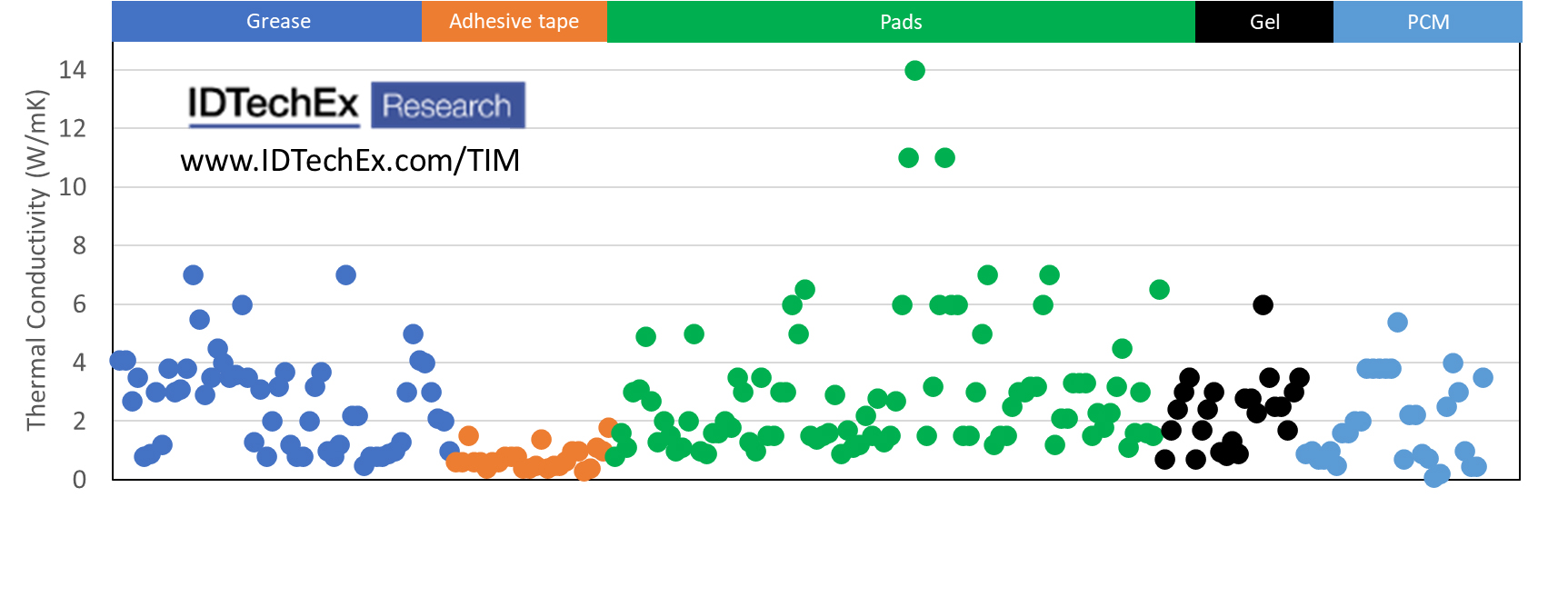
Thermal conductivity of various types of typical thermal interface solutions. This is of course not comprehensive as there are many solutions on the market. For more info please visit the IDTechEx report, “Thermal Interface Materials 2020-2030: Forecasts, Technologies, Opportunities”.
From Alumina to Boron Nitride to Nanostructures
The common fillers for insulating TIM materials are ceramics. The picture below explains the dynamics of the filler technology and the market positioning of fillers and related TIMs very well. This picture was taken in Japan three years ago by IDTechEx.
As seen below, low thermal conductivity fillers are generally based on alumina or ATH. These are lower cost. As a rule of thumb, TIMs within the 1 to 4W/mK thermal conductivity range use these fillers. This largely dictates their cost and price position in the market.
Alumina composite, boron nitride/alumina blends, and/or boron nitride become involved when going above 4-5W/mK. These materials are more expensive. Note that the developments around hexagonal boron nitride – particularly around particle size and morphology- have provided the basis to reach the 14-15W/mK with some even showing 17W/mK.
An interesting area of development is around boron nitride nanostructures, namely BN nanotubes (BNNT) and nanosheets (BNNS). The BNNTs today come in a wide range of prices depending on quality and morphology. The price range goes from 200$/g to more than 1,200$/g”! Huge price ranges to be found in other nano materials such as graphene and CNTs. Similarly, just like CNTs, BNNTs come in a variety of shapes. The aspect ratio and BET surface area of commercially available nanotubes differ by around 4 and 1 orders of magnitude, respectively. In general, BNNTs and BNNSs are at a relatively early stage of development and commercialization.
Some products are showing that BNNT powders dispersed in silicone can result in TIMs with 10-12 W/mK. Achieving high wt% loadings will be challenging without compromising viscosity. As such, BNNTs may be used in conjunction with other fillers. There is potential to further develop this technology, especially by using through plane alignment techniques.
To learn more about TIM technology and markets please see the IDTechEx report, “Thermal Interface Materials 2020-2030: Forecasts, Technologies, Opportunities”. This report provides a complete analysis of all the existing and emerging markets for TIM. It also provides an assessment of all the key existing and emerging TIM technologies.
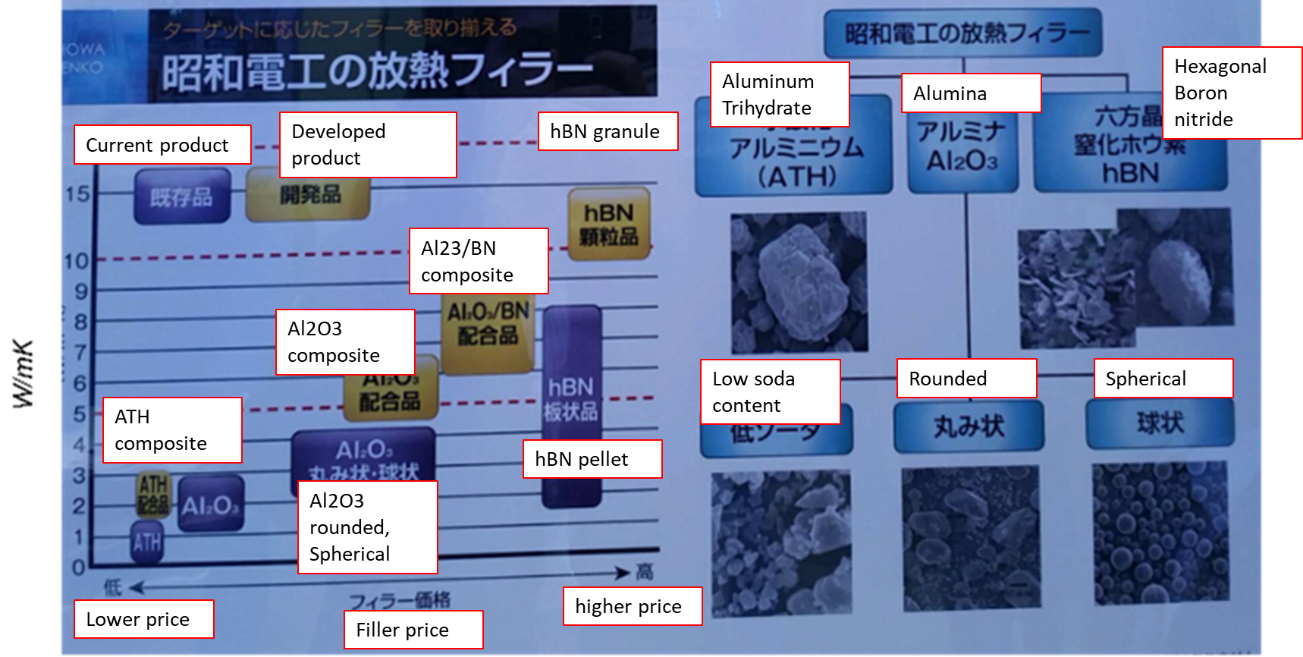
Picture taken by IDTechEx in Japan three years ago. This clearly explains the positioning of different fillers. This is developed by Showa Denko. For more info please visit “Thermal Interface Materials 2020-2030: Forecasts, Technologies, Opportunities”.
From Graphite to Carbon Fibre, Carbon Nanotubes, and Graphene
The discussion thus far was mainly focused on ceramic fillers, creating insulating TIMs. There are also many carbon fillers or carbon-based sheets which act as TIMs or thermal dissipation films.
Carbon is a gymnast of a material and so comes in many shapes and forms. As such, it gives rise to thermal films/sheets and TIMs covering a broad spectrum of thermal conductivity values both in- and through-plane. This is shown in the chart below, which is extracted from the IDTechEx thermal interface material report, “Thermal Interface Materials 2020-2030: Forecasts, Technologies, Opportunities”. The through-plane thermal conductivity benchmark chart includes rounded/spherical alumina in this chart to give a sense of scale.
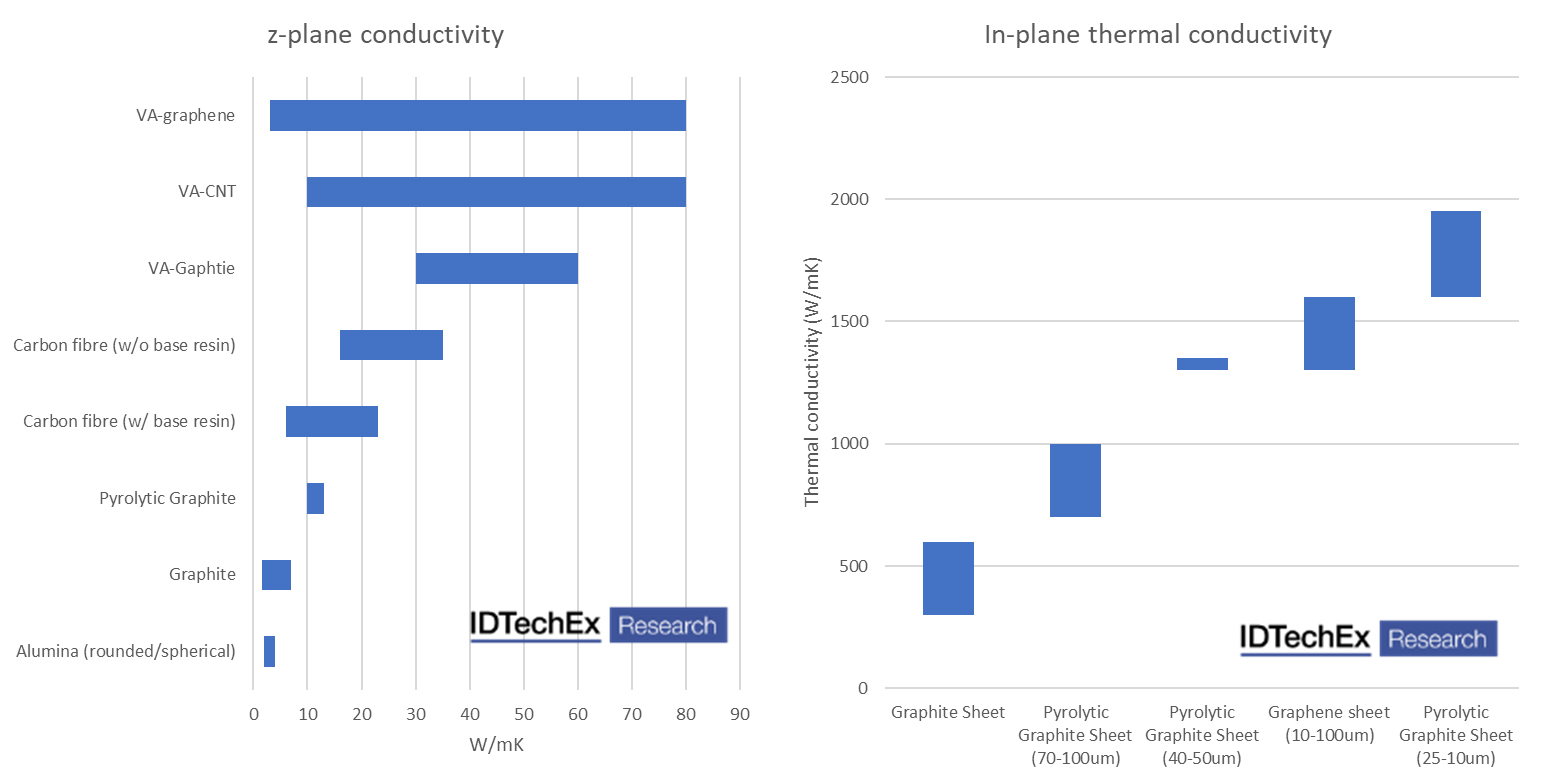
For more info please visit “Thermal Interface Materials 2020-2030: Forecasts, Technologies, Opportunities”.
Standard graphite is of course very common. It can come as a sheet, pad, or liquid. The in-plane conductivity values are very high. However, the through-plane conductivity is low – e.g., 7 W/mK. Multiple approaches have been developed to address this issue. One strategy is to mix graphite platelets with other materials which disrupt the horizontal flat alignment of the platelets, thus maintaining a strong vertical thermal path. Another strategy is to achieve fully vertically aligned graphite. In this case, the thermal conductivity can reach 60 W/mK or so. This is a very high z-direction thermal conductivity. A cross section of such a product is shown below. The IDTechEx team took this picture in Japan. Note that this material is very expensive on a $/sqm basis. To learn more please see the IDTechEx report, “Thermal Interface Materials 2020-2030: Forecasts, Technologies, Opportunities”.
There are some interesting innovations taking place. Using carbon fibre (CF) with its excellent anisotropic thermal conductivity as a filler to increase the through-plane thermal conductivity is a good one. The conductivity is particularly noticeable for the pitch-based variants (as opposed to PAN). The TIM can include a range of CF loadings or CF can be used as a standalone sheet (usually with a small amount of binder or other additives). A major innovation has been in the technique to vertically align the CFs. This product is already commercialized used in some flagship mobile phones. It boosts the thermal conductivity to levels not attainable using even boron nitride. Naturally, this higher thermal conductivity comes at a much higher price.
Carbon nanotubes (CNTs) and graphene are also both in play. The former can be grown in vertical forests, giving excellent z-axis thermal conductivity. Several Japanese companies have done excellent work here. One has reported best in-class champion results of around 80W/mK (z-direction) including the contact resistance. Another is commercialising products with- based on IDTechEx discussions- 10, 15, and 40 W/mK. As such, vertically aligned CNTs (VACNTs) can be as competitive as carbon fibre, whilst giving a pathway to supress what CF can achieve. Naturally, there are different CNT types and this means a broad price range.
Graphene also has excellent thermal properties. After a long commercialization journey, it looks like graphene has found market success using its thermal properties. One interesting product is in graphene thermal sheets or heat spreaders. These sheets with typical thicknesses around 20-100um exhibit 1,300-1,600 W/mK in-plane conductivity, surpassing the performance of standard graphite sheets. Its main competitor is PGS (pyrolytic graphite sheet). PGS can achieve 1950 W/mK but only at 10um thickness. As PGS’s thickness grows its thermal conductivity falls. For example, a 100um PGS offers only 700W/mK. It therefore appears that graphene is the performance leader for carbon-based thermal spreaders with thickness greater than 40um.
It is noteworthy that a leading Chinese mobile phone maker adopted graphene heat spreaders (see below), creating one of the larger graphene orders worldwide – e.g., around 200 tonnes. As a final note on graphene, IDTechEx have seen vertically aligned graphene nanoplatelets thermal pads achieving effective through-plane thermal conductivity of 80 W/mK under 2MPa compression. This puts it on the same competitive plane as leading VA-CNTs.

Examples VA-CNT, VA-graphite, and rGO (reduced graphene oxide sheet). I took the first picture at in Japan whilst I took the rGO pictures at the IDTechEx Show! in Berlin. The products are from Zeon (Japan), Hitachi Chemical (Japan), and Sixth Element (China). To learn more, please visit “Thermal Interface Materials 2020-2030: Forecasts, Technologies, Opportunities”.
For more information on this report, please visit www.IDTechEx.com/TIM or for the full portfolio of research available from IDTechEx please visit www.IDTechEx.com/Research.
About Us
IDTechEx guides your strategic business decisions through its Research, Consultancy and Event products, helping you profit from emerging technologies. For more information on IDTechEx Research and Consultancy, contact research@IDTechEx.com or visit www.IDTechEx.com.
Contacts